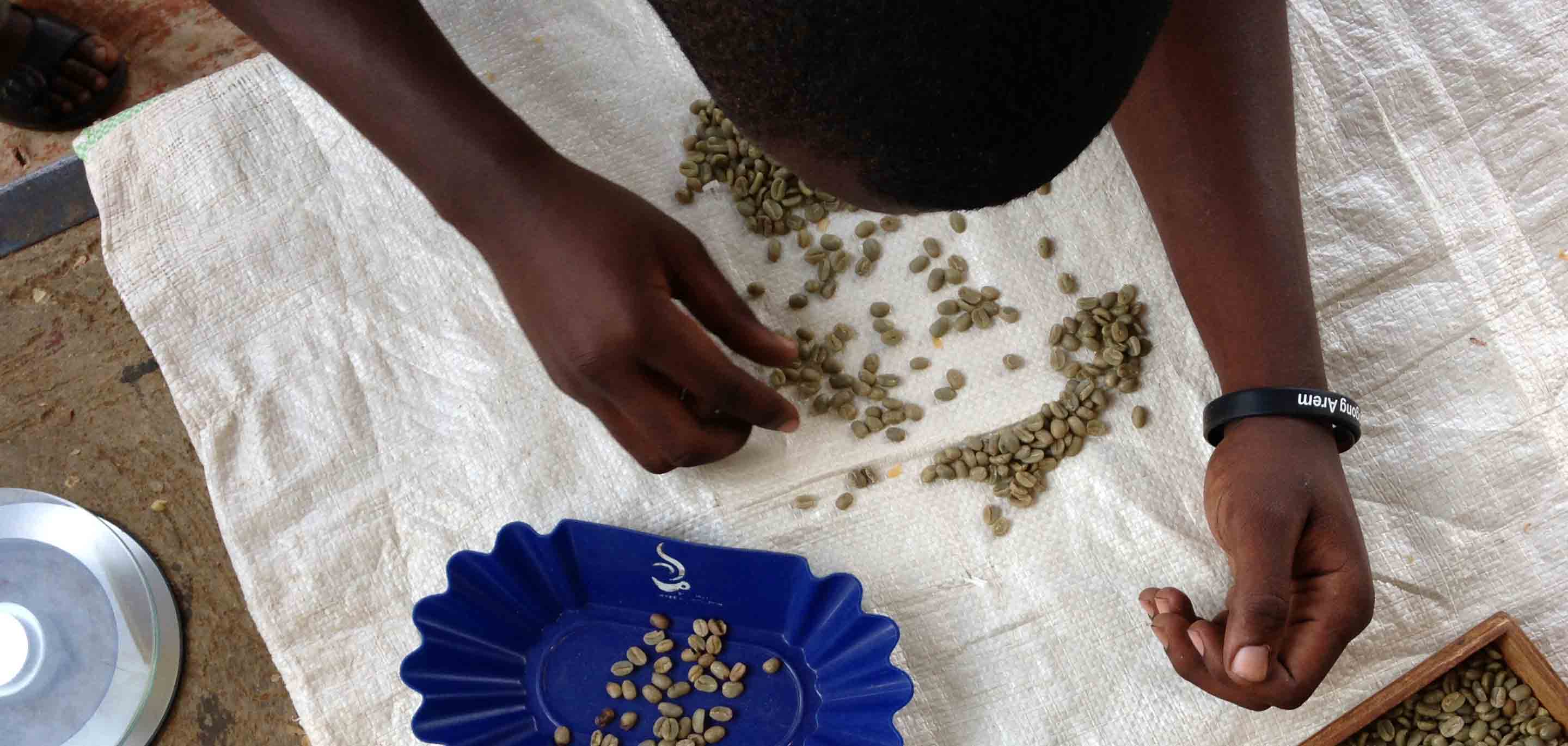
Our Blog
A Trip to Africa: Day 6 - The Mystery Coffee's Story
View BY :
A Trip to Africa: Day 6 - The Mystery Coffee's Story
In January 2014, CEO & Co-Founder Paul Katzeff traveled to Africa to meet with two of our producer cooperatives. In this blog series, Paul shares his experience in Uganda and Rwanda.
But what about the other 250 sacks along that back wall? Where did that come from and how did it pass defect inspection? And where was it going? Who had produced it, who had sold it? Who had purchased it and who had financed it? This was on my mind as we hit the road to Gumutindo’s dry mill, and it would play an important role in the days to come.
These mystery sacks of zero defect, 17 screen (large bean size) ready for export coffee were a sharp contrast to the coffee in parchment set aside for Thanksgiving Coffee's shipment. Where did they come from? We asked the Board and the General Manager. It was as if we had caught a thief . They could not account for the purchases . There was no record of this coffee being purchased by the cooperative from its members.
Then, as the pressure built for disclosure ( I threatened to dissolve our relationship of 10 years) JJ, the cooperative's founder revealed that the coffee was for Coexist, a Washington DC based charity with whom Thanksgiving Coffee had developed a relationship a year before.
So, the sacks were brought back to the PKC warehouse to await my arrival – perhaps they thought I would have some “pull” at the Mill to get the coffee through. This was not exactly the way the problem was presented to me by the PKC management. They pointed fingers and said they were being picked on and that was why they wanted me, their buyer, to front for them at the mill. I thought this sounded legitimate, so I went to the GM at Gumutindo that afternoon to plead their case.
Willington, the GM of Gumutindo who has visited me in California, offered to send his truck to pick up the parchment coffee and re-test it in front of the PKC Board. That way, they could see for themselves just what the defect percentage was in the batch of coffee slated for Thanksgiving Coffee Company from their 2013 crop. But what about the other 250 sacks along that back wall? Where did that come from and how did it pass defect inspection? And where was it going? Who had produced it, who had sold it? Who had purchased it and who had financed it? This was on my mind as we hit the road to Gumutindo’s dry mill, and it would play an important role in the days to come.
That is enough reading for today. In my next post I will tell you how we handled this situation, how it changed our plans for the next three days of our trip and caused Nick and I to re-route out flight back thru Washington DC to meet with Coexist's Executives. I took this photo of a local artists interpretation of a street market. Total Chaos! The picture was hanging in our Hotel Lobby.
To be continued...
-Paul
A Trip to Africa (series archive)
Day 2 – Dancing, Mango Trees & the Dry Mill
Day 4 – Transparency, Trust & Relationships
Day 5 - Coffee Quality & A New Mystery
Day 6 – The Mystery Coffee’s Story
Recommended Reading
Back to the Blog-
![How To Grow Coffee Trees]()
The Roots of Your Morning Brew: Understanding the Coffee Plant
For many, coffee is the ritualistic start to the day, a beloved beverage that energizes and comforts. Yet, beyond the steaming cups and aromatic brews lies the coffee plant, a botanical wonder that is the genesis of every coffee lover’s journey. At the heart of Thanksgiving Coffee Company is a deep appreciation for this living tree source—the company respects and values the entire process, from the nurturing soil that cradles the seed to the satisfying sip that completes the circle. We have been connecting to this plant by growing our own coffee trees right here for many years.
Coffee Trees Growing at the Thanksgiving Coffee Company Office
Anatomy of the Coffee Plant: More Than Just Beans
The coffee plant, with its glossy green leaves and ripe cherries, is both an aesthetic marvel and a complex organism. Beneath the soil, its roots anchor the plant and absorb vital nutrients. Above ground, the leaves play a crucial role in photosynthesis, while the bright red cherries house the precious beans inside. It's these beans that, once processed and roasted, give rise to the alluring aromas and rich flavors that characterize each cup of coffee.
Varied Flavors: The Many Varieties of Coffee Plants
Ripe coffee cherries on the Arabica coffee tree grown at the office
When you think of coffee, the two dominant species: Arabica and Robusta, likely come to mind. Arabica is prized for its smoother, more nuanced taste, while Robusta is revered for its robustness and higher caffeine content. However, there exists a myriad of lesser-known varieties, each with its own unique flavor profile, waiting to be discovered by eager coffee connoisseurs.
From the Soil to your first Sip: How Terroir Affects Your Coffee
Like fine wine, coffee is influenced by its terroir—the environment in which it's grown. The climate, soil composition, and even the angle of sunlight on the slopes where coffee plants thrive collectively contribute to the coffee's flavor profile. These factors, often subtle and complex, define a coffee's body, acidity, and notes, creating an array of tastes as diverse as the landscapes from which they come.
Ripe cherries harvested from our coffee trees.
Ready to Discover the Flavor of Your Own Coffee
If you are inspired to develop a closer relationship with your coffee and want to lean into the root system of your daily coffee ritual, we have a series for you. Our co-founder Paul Katzeff has been growing coffee trees at home for years, and will lead you through his process.
Check out the series:
Part I: The Beauty of Growing Coffee Trees in Your Home
Part II: All you Need to Know About Growing Coffee Trees At Home
Part III: Caring For Your Coffee Tree
Coffee Tree Source:
Lavender Grace is the Sustainability Consultant for Thanksgiving Coffee Company.
Growing Coffee At HomeHow To Grow Coffee Trees
read more -
![Rwanda Resilience in Every Cup: Coffee with a Climate Impact]()
Taste the Bright Future of Coffee
Our Rwanda Single Origin offers more than just incredible flavor—it’s a coffee that supports community resilience. Grown at high elevations in Musasa, Rwanda, by the Dukunde Kawa Cooperative.This medium roast delivers:- Tasting Notes: Vibrant citrus, delicate florals, and a smooth honey finish
- Mouthfeel: Silky and refreshing, with a bright, clean finish
- Perfect for: Pour over, drip, or French press—ideal for your morning clarity ritual
Rwanda Single Origin Coffee with citrus, floral, and honey tasting notes from Dukunde Kawa.
Why Dukunde Kawa Coffee Matters
Dukunde Kawa means “Let’s love coffee”—a name that reflects their commitment to people, planet, and flavor. This Rwandan cooperative is internationally recognized for combining exceptional quality with climate action.
Here's what climate resilience in action looks like:- 2,500+ clean cook stoves installed, reducing wood use by 70%
- Tree nurseries restoring biodiversity and combating soil erosion
- Women’s leadership with 80% women participation at the Ruli washing station
Every bag of Rwanda Single Origin supports these impactful programs, making every cup an act of regeneration and reciprocity.
Sources: Dukunde Kawa Sustainability Programs and Thanksgiving Coffee Dukunde Kawa Story
Rwanda Coffee Farm
Brew a Better Morning, Support a Better Future
Every time you brew Rwanda Single Origin, you:- Support healthier homes with clean cook stove initiatives
- Restore forests and farms through reforestation efforts
- Empower women farmers, nurturing local leadership
Recipe: Cold Brew for Summer Brightness
Show off the bright notes of Rwanda Single Origin with this easy cold brew:- Coarse grind 1 cup of beans
- Steep in 4 cups of filtered water for 12-14 hours
- Serve over ice with a twist of fresh orange peel
Refreshing, vibrant, and perfect for a summer coffee ritual.
Explore More Flavor Stories
Lavender Grace is the Sustainable Ecology Advocate for Thanksgiving Coffee Company
From the RoasteryRwanda Resilience in Every Cup: Coffee with a Climate Impact
read more -
![Women Powering Change: SOPPEXCCA's Revolutionary Approach to Economic Justice in Coffee]()
The Story Of SOPPEXCCA: Empowerment Through Coffee
In the verdant highlands of Jinotega, Nicaragua, a revolutionary approach to gender equity is transforming the coffee industry. Led by the visionary Fátima Ismael, SOPPEXCCA cooperative operates on a powerful belief: "Women's independence can only be achieved through economic autonomy and awareness."
"This groundbreaking initiative doesn't just produce exceptional coffee – it creates a model for sustainable economic justice." – Thanksgiving Coffee Company
What makes this partnership unique is SOPPEXCCA's pioneering recognition of women's traditionally invisible contributions to coffee production. This approach addresses a global challenge documented extensively by international organizations including the United Nations.
Fátima Ismael, SOPPEXCCA'S General Manager
The $40,000 Unpaid Work Fund: Valuing Invisible Labor
Since 2013, Thanksgiving Coffee Company has committed an additional $0.10 per pound of green coffee purchased from SOPPEXCCA – specifically allocated to recognize women's unpaid work. This initiative has now generated over $40,000 supporting women's economic empowerment.
The Global Context of Unpaid Labor
According to UN Women research:
- Unpaid care work is essential to functioning economies but often goes uncounted and unrecognized
- Women—particularly from low-income, migrant, and racialized groups—perform more than three-quarters of unpaid care and domestic work globally
- If women's unpaid work were assigned monetary value, it would exceed up to 40% of GDP in some countries
Measurable Impact in Nicaragua
The SOPPEXCCA initiative has created transformative changes for women:
- Improved relationships among women in rural communities
- Increased active participation in economic decision-making processes
- Development of creative potential within family economies
- Financial independence through personal savings accounts
- Growing cooperative membership among women
"8 March ... Day of commemoration and new commitments for a world of equality, equity and respect .. Greetings female producers, friends and companions who have been with this organization on their way that has not been easy but together we have overcome a thousand adversities and will continue to be fighting ..." Soppexcca
Woman Farmers of Soppexcca Cooperative - Jinotego, Nicaragua
Environmental Stewardship Meets Social Justice
Shade Grown Coffee: Critical Habitat for Migratory Songbirds
SOPPEXCCA's commitment extends beyond economic justice. Their shade-grown cultivation methods create essential winter habitats for migratory songbirds, demonstrating how sustainable agriculture directly contributes to biodiversity conservation.
"When you choose SOPPEXCCA coffee, you're supporting both women's empowerment and environmental stewardship – values at the heart of Thanksgiving Coffee Company."
Woman Farmers from the Soppexxcca Cooperative - Jinotega, Nicaragua
The Economic Impact Of Ethical Investment
UN Women's research reveals that investing in care infrastructure creates three times more jobs than equivalent investment in construction, with 70-90% of these jobs benefiting women.
The SOPPEXCCA fund represents precisely this kind of strategic investment.
Read about our support for the women of Soppexcca:
"Recognizing the Value of Womens Unpaid Work".
Celebrate the Women Coffee Farmers of Soppexcca
Try this delicious coffee and support a more balanced and just economy for the women of Soppexcca.
Lavender Grace is the Sustainability Consultant for Thanksgiving Coffee Company.
international woman's dayWomen Powering Change: SOPPEXCCA's Revolutionary Approach to Economic Justice in Coffee
read more
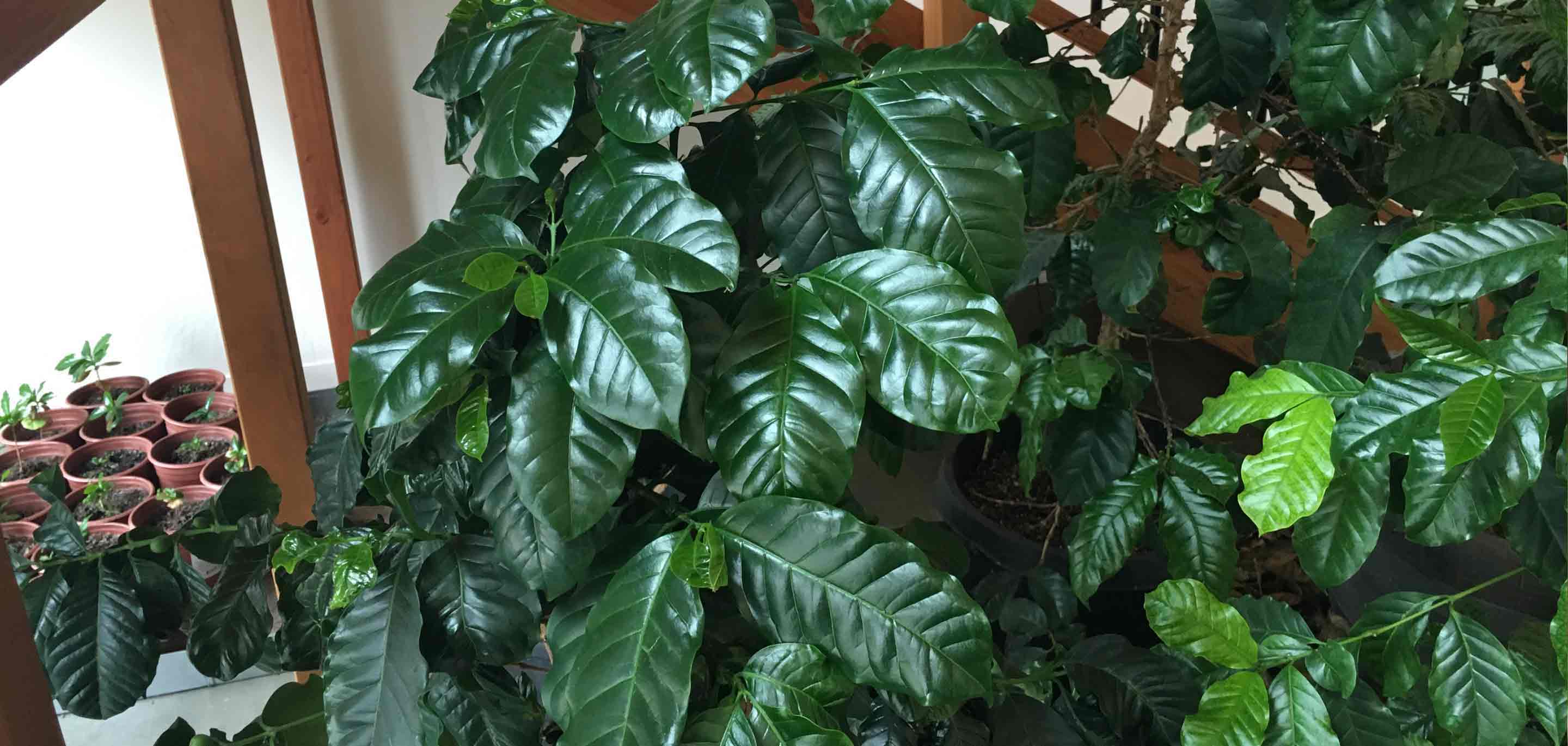
The Roots of Your Morning Brew: Understanding the Coffee Plant
For many, coffee is the ritualistic start to the day, a beloved beverage that energizes and comforts. Yet, beyond the steaming cups and aromatic brews lies the coffee plant, a botanical wonder that is the genesis of every coffee lover’s journey. At the heart of Thanksgiving Coffee Company is a deep appreciation for this living tree source—the company respects and values the entire process, from the nurturing soil that cradles the seed to the satisfying sip that completes the circle. We have been connecting to this plant by growing our own coffee trees right here for many years.
Coffee Trees Growing at the Thanksgiving Coffee Company Office
Anatomy of the Coffee Plant: More Than Just Beans
The coffee plant, with its glossy green leaves and ripe cherries, is both an aesthetic marvel and a complex organism. Beneath the soil, its roots anchor the plant and absorb vital nutrients. Above ground, the leaves play a crucial role in photosynthesis, while the bright red cherries house the precious beans inside. It's these beans that, once processed and roasted, give rise to the alluring aromas and rich flavors that characterize each cup of coffee.
Varied Flavors: The Many Varieties of Coffee Plants
Ripe coffee cherries on the Arabica coffee tree grown at the office
When you think of coffee, the two dominant species: Arabica and Robusta, likely come to mind. Arabica is prized for its smoother, more nuanced taste, while Robusta is revered for its robustness and higher caffeine content. However, there exists a myriad of lesser-known varieties, each with its own unique flavor profile, waiting to be discovered by eager coffee connoisseurs.
From the Soil to your first Sip: How Terroir Affects Your Coffee
Like fine wine, coffee is influenced by its terroir—the environment in which it's grown. The climate, soil composition, and even the angle of sunlight on the slopes where coffee plants thrive collectively contribute to the coffee's flavor profile. These factors, often subtle and complex, define a coffee's body, acidity, and notes, creating an array of tastes as diverse as the landscapes from which they come.
Ripe cherries harvested from our coffee trees.
Ready to Discover the Flavor of Your Own Coffee
If you are inspired to develop a closer relationship with your coffee and want to lean into the root system of your daily coffee ritual, we have a series for you. Our co-founder Paul Katzeff has been growing coffee trees at home for years, and will lead you through his process.
Check out the series:
Part I: The Beauty of Growing Coffee Trees in Your Home
Part II: All you Need to Know About Growing Coffee Trees At Home
Part III: Caring For Your Coffee Tree
Coffee Tree Source:
Lavender Grace is the Sustainability Consultant for Thanksgiving Coffee Company.
How To Grow Coffee Trees
read more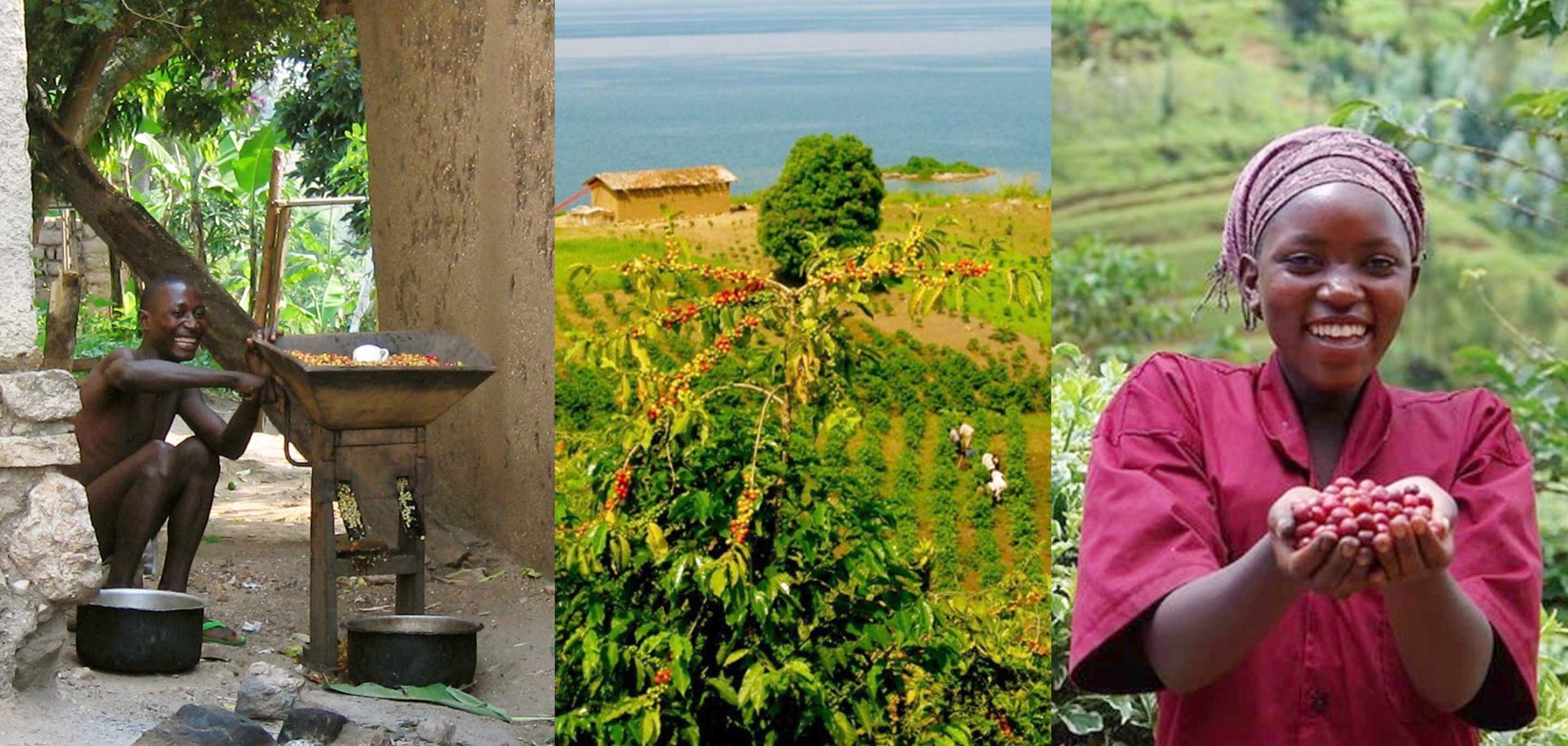
Taste the Bright Future of Coffee
- Tasting Notes: Vibrant citrus, delicate florals, and a smooth honey finish
- Mouthfeel: Silky and refreshing, with a bright, clean finish
- Perfect for: Pour over, drip, or French press—ideal for your morning clarity ritual
Rwanda Single Origin Coffee with citrus, floral, and honey tasting notes from Dukunde Kawa.
Why Dukunde Kawa Coffee Matters
Dukunde Kawa means “Let’s love coffee”—a name that reflects their commitment to people, planet, and flavor. This Rwandan cooperative is internationally recognized for combining exceptional quality with climate action.
- 2,500+ clean cook stoves installed, reducing wood use by 70%
- Tree nurseries restoring biodiversity and combating soil erosion
- Women’s leadership with 80% women participation at the Ruli washing station
Every bag of Rwanda Single Origin supports these impactful programs, making every cup an act of regeneration and reciprocity.
Sources: Dukunde Kawa Sustainability Programs and Thanksgiving Coffee Dukunde Kawa Story
Rwanda Coffee Farm
Brew a Better Morning, Support a Better Future
- Support healthier homes with clean cook stove initiatives
- Restore forests and farms through reforestation efforts
- Empower women farmers, nurturing local leadership
Recipe: Cold Brew for Summer Brightness
- Coarse grind 1 cup of beans
- Steep in 4 cups of filtered water for 12-14 hours
- Serve over ice with a twist of fresh orange peel
Explore More Flavor Stories
Lavender Grace is the Sustainable Ecology Advocate for Thanksgiving Coffee Company
Rwanda Resilience in Every Cup: Coffee with a Climate Impact
read more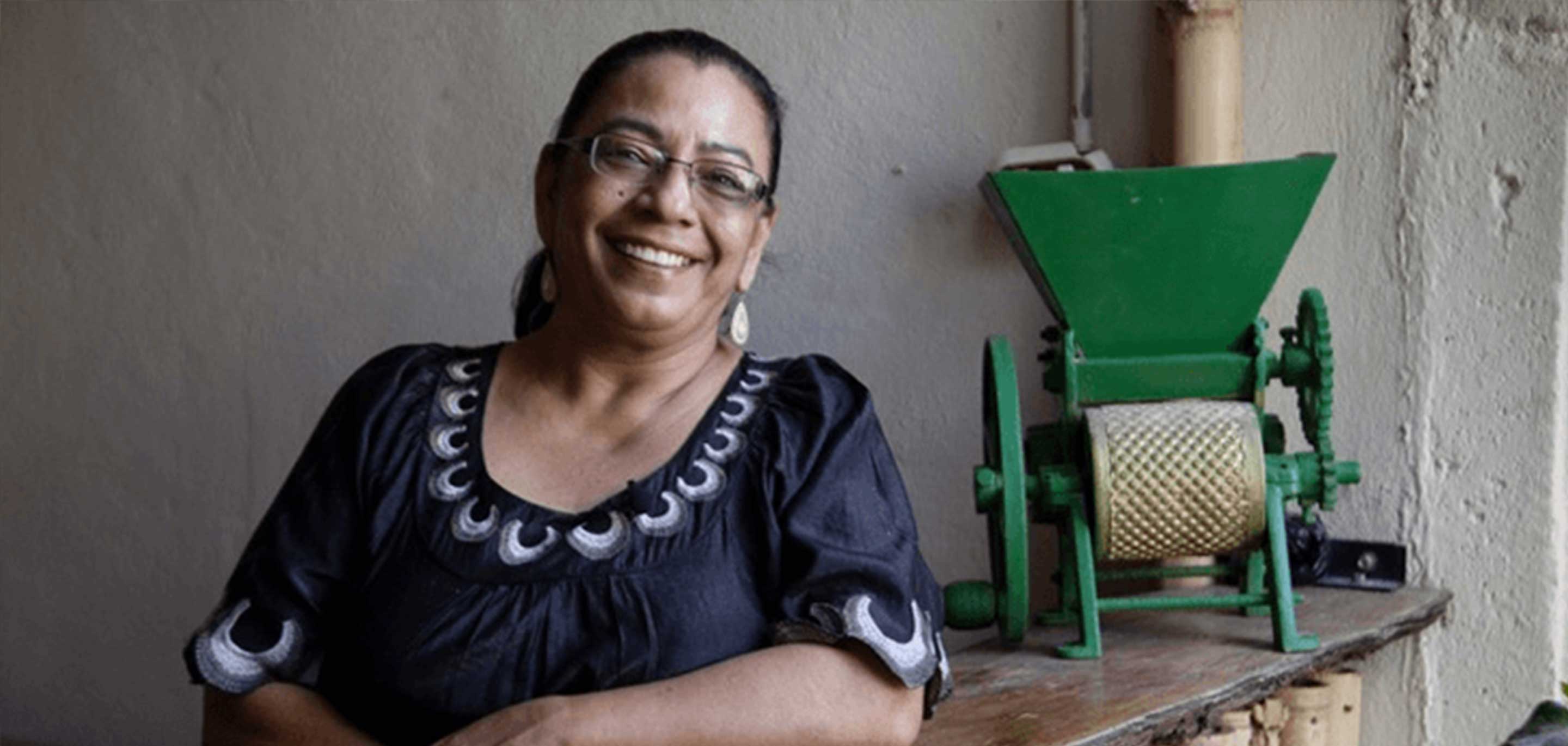
The Story Of SOPPEXCCA: Empowerment Through Coffee
In the verdant highlands of Jinotega, Nicaragua, a revolutionary approach to gender equity is transforming the coffee industry. Led by the visionary Fátima Ismael, SOPPEXCCA cooperative operates on a powerful belief: "Women's independence can only be achieved through economic autonomy and awareness."
"This groundbreaking initiative doesn't just produce exceptional coffee – it creates a model for sustainable economic justice." – Thanksgiving Coffee Company
What makes this partnership unique is SOPPEXCCA's pioneering recognition of women's traditionally invisible contributions to coffee production. This approach addresses a global challenge documented extensively by international organizations including the United Nations.
Fátima Ismael, SOPPEXCCA'S General Manager
The $40,000 Unpaid Work Fund: Valuing Invisible Labor
Since 2013, Thanksgiving Coffee Company has committed an additional $0.10 per pound of green coffee purchased from SOPPEXCCA – specifically allocated to recognize women's unpaid work. This initiative has now generated over $40,000 supporting women's economic empowerment.
The Global Context of Unpaid Labor
According to UN Women research:
- Unpaid care work is essential to functioning economies but often goes uncounted and unrecognized
- Women—particularly from low-income, migrant, and racialized groups—perform more than three-quarters of unpaid care and domestic work globally
- If women's unpaid work were assigned monetary value, it would exceed up to 40% of GDP in some countries
Measurable Impact in Nicaragua
The SOPPEXCCA initiative has created transformative changes for women:
- Improved relationships among women in rural communities
- Increased active participation in economic decision-making processes
- Development of creative potential within family economies
- Financial independence through personal savings accounts
- Growing cooperative membership among women
"8 March ... Day of commemoration and new commitments for a world of equality, equity and respect .. Greetings female producers, friends and companions who have been with this organization on their way that has not been easy but together we have overcome a thousand adversities and will continue to be fighting ..." Soppexcca
Woman Farmers of Soppexcca Cooperative - Jinotego, Nicaragua
Environmental Stewardship Meets Social Justice
Shade Grown Coffee: Critical Habitat for Migratory Songbirds
SOPPEXCCA's commitment extends beyond economic justice. Their shade-grown cultivation methods create essential winter habitats for migratory songbirds, demonstrating how sustainable agriculture directly contributes to biodiversity conservation.
"When you choose SOPPEXCCA coffee, you're supporting both women's empowerment and environmental stewardship – values at the heart of Thanksgiving Coffee Company."
Woman Farmers from the Soppexxcca Cooperative - Jinotega, Nicaragua
The Economic Impact Of Ethical Investment
UN Women's research reveals that investing in care infrastructure creates three times more jobs than equivalent investment in construction, with 70-90% of these jobs benefiting women.
The SOPPEXCCA fund represents precisely this kind of strategic investment.
Read about our support for the women of Soppexcca:
"Recognizing the Value of Womens Unpaid Work".
Celebrate the Women Coffee Farmers of Soppexcca
Try this delicious coffee and support a more balanced and just economy for the women of Soppexcca.
Lavender Grace is the Sustainability Consultant for Thanksgiving Coffee Company.
Women Powering Change: SOPPEXCCA's Revolutionary Approach to Economic Justice in Coffee
read more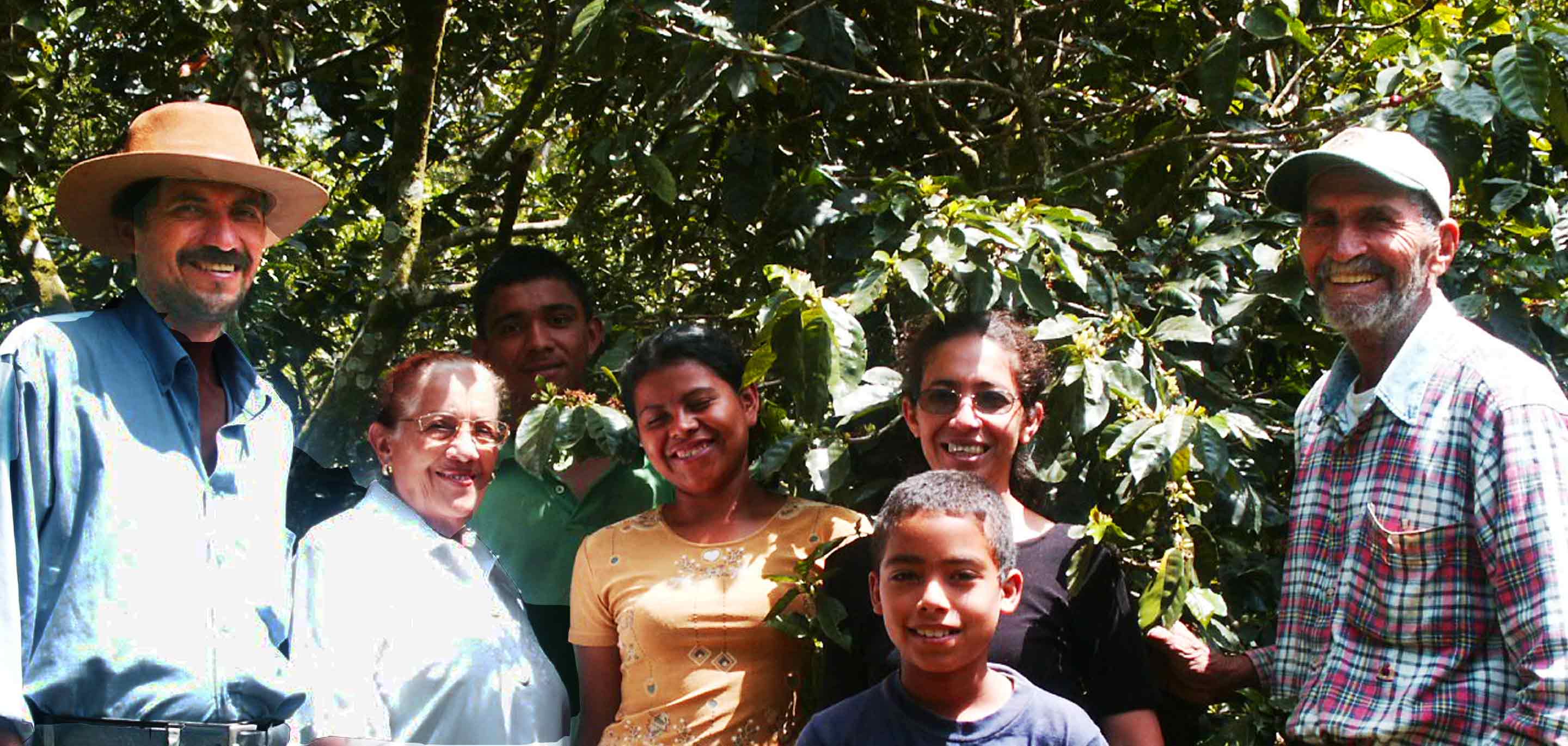
Pioneering Regenerative Agriculture
High in Nicaragua's pristine Arenal Forest Reserve, at 1,500 meters above sea level, Finca los Pinos stands as a testament to agricultural transformation. Here, Byron Corrales and his family have spent over four decades pioneering a different way of farming coffee. Since embracing organic practices in 1986, they've developed an innovative approach that works in perfect harmony with nature. Through their dedication to biodynamic farming, they've not only twice earned top honors for their extraordinary coffee, but they've also created a model for sustainable agriculture that's changing how we think about coffee cultivation.
Sarah Corrales on her families coffee farm
Byron Corrales hugging a tree on his family coffee farm
A Legacy of Excellence
Our relationship with the Corrales family spans three generations, witnessing their evolution from traditional farming to becoming leaders in biodynamic agriculture. Byron's innovative spirit led him to develop the exceptional Maracaturra variety, a unique hybrid that produces remarkably large beans – distinctively bigger than typical Arabica coffee beans. This size isn't just for show; it allows for exceptional taste elements that smaller beans simply cannot achieve, delivering a remarkable sweetness and richness in every cup.
Benita Corrales, Byron's mother
The first meeting with Thanksgiving Coffee Company in 1992- Left Byron Corrales, Right Arnulfo Corrales
Arnulfo Corrales, Byron's father
Left to right - Thanksgiving Coffee's Co-Founder Paul Katzeff, Byron Corrales, and Nick Hodgkins (Etico -The ethical trading company)
the Art Of Processing
Byron with drying natural Maracaturra coffee beans.
Corrales' artisanal approach to processing begins long before the cherries reach the beneficio (drying patio). On his farm, every element serves an integral function in creating exceptional coffee. This includes the carefully selected forage crops sustaining his cattle, whose manure enriches the compost used around the coffee trees, as well as the diverse pollinators - from honeybees to other beneficial insects - that support optimal cherry development.
For Corrales, successful coffee processing stems from creating a balanced, thriving ecosystem that produces the highest quality cherries possible for processing. This foundation of environmental harmony directly influences the clarity and complexity of his final cup.
The Natural process is when the coffee cherries are dried whole, without removing the pulp or using water or machines, and has become Byron’s preferred method for many reasons, as he explained in this video. It is a very good choice to reduce the use of fossil fuels and for water conservation, as well as the added antioxidant health benefits.
The Living Systems Of Los Pinos
At Finca los Pinos, every element serves multiple purposes in an intricate dance of mutual support:
- Native and planted trees provide essential shade and soil health
- Free-ranging cattle contribute to natural fertilization cycles
- Coffee cherry pulp (cascara) is recycled into nutritious cattle feed
- Birds and beneficial insects maintain natural pest control
- Pine trees create unique conditions that enhance both soil and coffee quality
Los Pinos coffee farm looking out over the forest
Soil: The Foundation of Life
Byron Corrales with his hands full of soil
Byron's approach to soil health demonstrates the core principles of regenerative agriculture. "The farmers that produce with agrochemicals and herbicides destroy the life of the soil," he observes. "We protect it." This protection includes:
- Maintaining ground cover to retain moisture
- Supporting microorganism and mycorrhizal networks
- Using natural fertilization methods
- Working with, rather than against, natural processes
“I feel really happy that those who drink my coffee are drinking a cup of life”
Byron Corrales
Climate Resilience Through Diversity
Great video produced by Viva La Finca - Virtual origin experience - Byron Corrales of Finca Los Pinos
Understanding the challenges of climate change, Byron has implemented robust adaptation strategies:
- Diverse tree species for enhanced shade coverage
- Strengthened soil biology
- Natural mineral enrichment
- Water conservation systems
The Unique Maracaturra Experience
This regenerative approach culminates in the cultivation of Maracaturra, a special variety found only at Finca los Pinos. This unique hybrid of Maragoype and Caturra (Bourbon) produces a truly exceptional coffee with:
- Juicy apricot aromatics
- Rich cashew nuttiness
- A deeply toned sweet cacao finish
- Remarkable sweetness unique to the large bean size
- Complex flavor elements impossible to achieve with conventional varieties
A Vision for the Future
"I want to transmit our family's art, our work of many years, discovering the flavors we've learned to bring forth from our mountains, expressed in this cup by way of respect for our environment," Byron shares. This respect for environment and commitment to regenerative practices creates coffee that is, in Byron's words, "the expression of life and the life energy of all the living beings who live in our community."
The Corrales Family from one of our origin trips.
Each cup of Byron's coffee embodies a powerful truth: regenerative agriculture can produce extraordinary coffee while healing the earth.
Our Byron's Blend is where ancient farming wisdom meets modern artistry. By masterfully combining washed and natural processed Maracaturra coffees, we create a harmonious cup that showcases the finest expressions of both methods. The result is more than a blend – it's a testament to coffee craftsmanship at its peak.
As Byron himself reminds us with characteristic wisdom: we are "celebrating with joy the responsibility of protecting the future of our generations." In every sip, you taste that promise.
Lavender Grace is the Sustainability Consultant for Thanksgiving Coffee Company.


